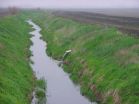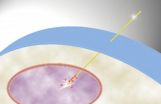(Press-News.org) URBANA – Tile drainage in the Mississippi Basin is one of the great advances of the 19th and 20th centuries, allowing highly productive agriculture in what was once land too wet to farm. In fact, installation of new tile systems continues every year, because it leads to increased crop yields. But a recent study shows that the most heavily tile-drained areas of North America are also the largest contributing source of nitrate to the Gulf of Mexico, leading to seasonal hypoxia. In the summer of 2010 this dead zone in the Gulf spanned over 7,000 square miles.
Scientists from the U of I and Cornell University compiled information on each county in the Mississippi River basin including crop acreage and yields, fertilizer inputs, atmospheric deposition, number of people, and livestock to calculate all nitrogen inputs and outputs from 1997 to 2006. For 153 watersheds in the basin, they also used measurements of nitrate concentration and flow in streams, which allowed them to develop a statistical model that explained 83 percent of the variation in springtime nitrate flow in the monitored streams. The greatest nitrate loss to streams corresponded to the highly productive, tile-drained cornbelt from southwest Minnesota across Iowa, Illinois, Indiana, and Ohio.
This area of the basin has extensive row cropping of fertilized corn and soybeans, a flat landscape with tile drainage, and channelized ditches and streams to facilitate drainage.
"Farmers are not to blame," said University of Illinois researcher Mark David. "They are using the same amount of nitrogen as they were 30 years ago and getting much higher corn yields, but we have created a very leaky agricultural system. This allows nitrate to move quickly from fields into ditches and on to the Gulf of Mexico. We need policies that reward farmers to help correct the problem."
David is a biogeochemist who has been studying the issue since 1993. "We've had data from smaller watersheds for some time, but this new study includes data from the entire Mississippi Basin. It shows clearly where across the entire basin the sources of nitrate are.
"A lot of people just want to blame fertilizer, but it's not that simple," David said. "It's fertilizer on intensive corn and soybean agricultural rotations in heavily tile-drained areas. There is also an additional source of nitrogen from sewage effluent from people, although that is a small contribution. It's all of these factors together."
David said that ripping out all of the drainage tiles is not a viable option. "Creating wetlands and reservoirs such as Lake Shelbyville can remove nitrate by holding the water back and letting natural processes remove it, but that's not a solution. It's expensive and we can't flood everyone's land to stop nitrate. That's not going to happen."
"The problem is correctable but will take a concerted effort to change the outcome, with some of the solutions expensive. Installing small wetlands or bioreactors at the end of tile lines that remove nitrates before they flow into the ditch do work, but would cost thousands of dollars per drain. Who's going to pay for that?" David said.
Cover crops can hold the nutrients so they are available in the spring, and are reasonably cheap, David said, but can increase the farmer's risk for the following crop. "So if a farmer plants a cover crop and his neighbor doesn't, he may be at a disadvantage."
David believes that the system can be improved by focusing conservation efforts on the
areas of the country that are contributing the most nitrate loss and establish an incentive program for farmers to utilize one or more practices known to reduce nitrate losses from tile lines.
Encouraging farmers to apply the right amount of nitrogen in the spring rather than the fall (or to sidedress), establishing a more complex cropping system which incorporates cover crops or even biofuel crops such as Miscanthus or switchgrass when there are markets, and installing end-of-pipe solutions such as controlled drainage, bioreactors, or wetlands are some of the efforts David suggests would help reduce nitrate loss.
"Until we change the payment system beyond our focus on yield alone, we're not going to make much progress in reducing nitrate losses. We also haven't developed voluntary programs that really address nitrate loss from tiles, and we need to provide more incentive and cost-share funding to producers. We may also need regulation. We could say to producers, if you buy fertilizer, you've got to do one of these five things," he said. "There's no one solution."
Dennis McKenna of the Illinois Department of Agriculture said "Dr. David's work is an important contribution in helping producers and policy makers identify the most critical areas. Hopefully this information will be used to develop a focused national and state effort to reduce nutrient losses to surface water."
Sources of Nitrate Yields in the Mississippi River Basin was published in the September-October 2010 issue of the Journal of Environmental Quality.
INFORMATION:
This research was funded by the National Science Foundation Biocomplexity in the Environment/Coupled Natural-Human Cycles Program. Authors in addition to David were Greg McIsaac from the University of Illinois and Laurie Drinkwater from Cornell University.
Tile drainage directly related to nitrate loss
2010-09-28
ELSE PRESS RELEASES FROM THIS DATE:
Urban gardeners beware: There may be lead in your soil and food
2010-09-28
INDIANAPOLIS – Not since victory gardens helped World War II era Americans on the home front survive food shortages have urban gardens been as necessary and popular as they are today. With more food production in cities, the safety of the produce grown there becomes increasingly important.
As city dwellers across the country are harvesting fruits and vegetables for family consumption and planning ahead for the next planting season, geochemist Gabriel Filippelli, Ph.D., professor of earth sciences at the School of Science at Indiana University-Purdue University Indianapolis, ...
A shot to the heart: Nanoneedle delivers quantum dots to cell nucleus
2010-09-28
CHAMPAIGN, Ill. — Getting an inside look at the center of a cell can be as easy as a needle prick, thanks to University of Illinois researchers who have developed a tiny needle to deliver a shot right to a cell's nucleus.
Understanding the processes inside the nucleus of a cell, which houses DNA and is the site for transcribing genes, could lead to greater comprehension of genetics and the factors that regulate expression. Scientists have used proteins or dyes to track activity in the nucleus, but those can be large and tend to be sensitive to light, making them hard ...
Study: Electric cars hold greater promise for reducing emissions and lowering US oil imports
2010-09-28
Electric cars hold greater promise for reducing emissions and lowering U.S. oil imports than a national renewable portfolio standard, according to research conducted by Rice University's Baker Institute for Public Policy.
This assessment is among several contained in a new major policy study the Baker Institute Energy Forum will release at a Sept. 27-28 conference titled "Energy Market Consequences of an Emerging U.S. Carbon Management Policy." The study comprises several academic working papers on a variety of topics, such as carbon pricing, the wind industry, global ...
How injured nerves grow themselves back
2010-09-28
Unlike nerves of the spinal cord, the peripheral nerves that connect our limbs and organs to the central nervous system have an astonishing ability to regenerate themselves after injury. Now, a new report in the October 1st issue of Cell, a Cell Press publication, offers new insight into how that healing process works.
"We know a lot about how various cell types differentiate during development, but after a serious injury like an amputation, nerves must re-grow," said Allison Lloyd of University College London. "They need a new mechanism to do that because the developmental ...
Rain or shine, Sandia researchers find new ways to forecast large photovoltaic power plant output
2010-09-28
ALBUQUERQUE, N.M. – Sandia National Laboratories researchers have developed a new system to monitor how clouds affect large-scale solar photovoltaic (PV) power plants. By observing cloud shape, size and movement, the system provides a way for utility companies to predict and prepare for fluctuations in power output due to changes in weather. The resulting models will provide utility companies with valuable data to assess potential power plant locations, ramp rates and power output.
Sandia researchers' work is currently focused at the 1.2-megawatt La Ola Solar Farm on ...
New guideline finds no evidence for a popular back procedure
2010-09-28
Rosemont, Ill. – As a patient safety best practice and endorsement of evidence-based medicine, the American Academy of Orthopaedic Surgeons (AAOS) Board of Directors approved and released a clinical practice guideline, which found a strong recommendation against a popular procedure called vertebroplasty as a way to treat fractures in the spine. Clinical practice guidelines are one avenue the Academy uses to ensure that patients receive high quality care.
Vertebroplasty is a surgical procedure developed to reduce or eliminate the pain associated with compression fractures ...
Sugary sports drinks mistakenly associated with being healthy, say UTHealth researchers
2010-09-28
HOUSTON (Sept. 27, 2010) – Children who practice healthy lifestyle habits such as eating fruits and vegetables and engaging in physical activity may be negatively impacting their health because they tend to consume large amounts of flavored and sports beverages containing sugar, according to research at The Michael & Susan Dell Center for Healthy Living at The University of Texas Health Science Center at Houston (UTHealth).
"Children and parents associate these drinks with a healthy lifestyle despite their increased amount of sugar and lack of nutritional value," said ...
Onconova Therapeutics presents new data demonstrating radioprotection by Ex-RAD at RRS annual meeting
2010-09-28
Newtown, PA, September 27, 2010 – Onconova Therapeutics, Inc. is presenting new data in five posters and an oral presentation this week summarizing several studies with the company's radioprotectant Ex-RAD® at the 56th Annual Meeting of the Radiation Research Society (RRS), September 25-29 in Maui, Hawaii. In vivo studies show that Ex-RAD®, upon oral administration, produced a significant increase in survival versus placebo-treated groups in mice exposed to lethal whole body irradiation (WBI), for both prophylactic pre-treatment and mitigation post-treatment. ...
'Gold' fish thrive, cancers die
2010-09-28
Rice University physicist Dmitri Lapotko has demonstrated that plasmonic nanobubbles, generated around gold nanoparticles with a laser pulse, can detect and destroy cancer cells in vivo by creating tiny, shiny vapor bubbles that reveal the cells and selectively explode them.
A paper in the October print edition of the journal Biomaterials details the effect of plasmonic nanobubble theranostics on zebra fish implanted with live human prostate cancer cells, demonstrating the guided ablation of cancer cells in a living organism without damaging the host.
Lapotko and his ...
Family, culture affect whether intelligence leads to education
2010-09-28
Intelligence isn't the only thing that predicts how much education people get; family, culture, and other factors are important, too. A new study published in Psychological Science, a journal of the Association for Psychological Science, compares identical and fraternal twins in Minnesota and Sweden to explore how genetic and environmental factors involved in educational differ in countries with different educational systems. Family background can get an education even for people of low intelligence, the authors conclude—but helps much more in Minnesota, than in Sweden.
The ...


